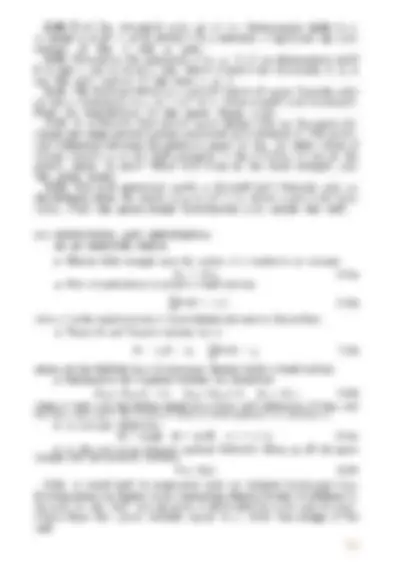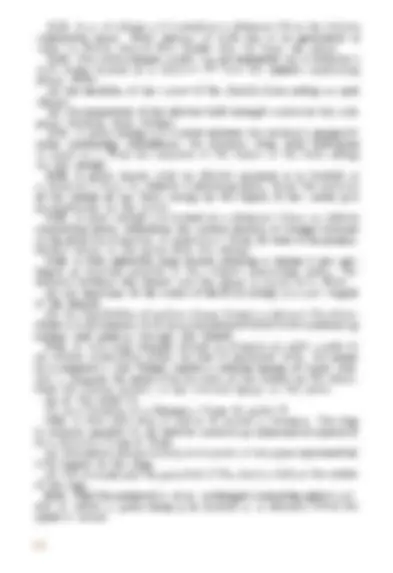





Study with the several resources on Docsity

Earn points by helping other students or get them with a premium plan


Prepare for your exams
Study with the several resources on Docsity

Earn points to download
Earn points by helping other students or get them with a premium plan
Community
Ask the community for help and clear up your study doubts
Discover the best universities in your country according to Docsity users
Free resources
Download our free guides on studying techniques, anxiety management strategies, and thesis advice from Docsity tutors
irodov_problems_in_general_physics_2011
Typology: Study Guides, Projects, Research
1 / 5

This page cannot be seen from the preview
Don't miss anything!




3.31. There is an infinitely long straight thread carrying a charge with linear density X, = 0.40 RC/m. Calculate the potential difference between points 1 and 2 if point 2 is removed it = 2.0 times farther from the thread than point I. 3.32. Find the electric field potential and strength at the centre of a hemisphere of radius R charged uniformly with the surface density a. 3.33. A very thin round plate of radius R carrying a uniform sur- face charge density a is located in vacuum. Find the electric field potential and strength along the plate's axis as a function of a dis- tance 1 from its centre. Investigate the obtained expression at 1--4- 0 and / » R. 3.34. Find the potential pat the edge of a thin disc of radius (^) R carrying the uniformly distributed charge with surface densi- ty a. 3.35. Find the electric field strength vector if the potential of this field has the form p = ar, where a is a constant vector, and r is the radius vector of a point of the field. 3.36. Determine the electric field strength vector if the potential
where a is a constant. Draw the approximate shape of these fields .using lines of force (in the x, y plane). 3.37. The potential of a certain electrostatic field has the form
nitude and direction of the electric field strength vector. What shape have the equipotential surfaces in the following cases:
a sphere of radius R. Assuming the permittivity to be equal to unity throughout, find the potential (a) at the centre of the sphere;
3.39. Demonstrate that the potential of the field generated by a dipole with the electric moment p (Fig. 3.4) may be represented as pr/4nsor3, where r is the radius vector. Using this expression, find the magnitude of the electric field strength vector as a function of r z and 0. 3.40. A point dipole with an electric moment p^9 oriented in the positive direction of the z axis is
projections E z and E1of the electric field strength vector (on the plane perpendicular to the z axis at (^) Fig. 3.4. the point S (see Fig. 3.4)). At which points is E perpendicular to p? 3.41. A point electric dipole with a moment p is placed in the external uniform electric field whose strength equals E0, with
dipole forms a sphere. Find the radius of this sphere. 3.42. Two thin parallel threads carry a uniform charge with linear densities X and —X. The distance between the threads is equal to 1. Find the potential of the electric field and the magnitude of its strength vector at the distance r >> 1 at the angle 0 to the vector 1 (Fig. 3.5). 3.43. Two coaxial rings, each of radius R, made of thin wire are separated by a small distance (^) 1 (1 < R) and carry the charges q and —q. Find the electric field potential and strength at the axis of the
2'
Fig. 3.5. Fig. 3.6. Fig. 3.7.
system as a function of the x coordinate (Fig. 3.6). Show in the same drawing the approximate plots of the functions obtained. Investigate
3.44. Two infinite planes separated by a distance 1 carry a uniform surface charge of densities a and —u (Fig. 3.7). The planes have round coaxial holes of radius //, with 1 < R. Taking the origin O and the x coordinate axis as shown in the figure, find the potential of the electric field and the projection of its strength vector E x on the axes of the system as functions of the x coordinate. Draw the approx- imate plot cp (x). 3.45. An electric capacitor consists of thin round parallel plates,
charged with surface densities a and —a. Find the potential of the electric field and the magnitude of its strength vector at the axes of the capacitor as functions of a distance x from the plates if x > 1. Investigate the obtained expressions at x » R. 3.46. A dipole with an electric moment p is located at a distance r from a long thread charged uniformly with a linear density X. Find the force F acting on the dipole if the vector p is oriented (a) along the thread; (b) along the radius vector r; (c) at right angles to the thread and the radius vector r. 3.47. Find the interaction force between two water molecules separated by a distance 1 = 10 nm if their electric moments are oriented along the same straight line. The moment of each molecule equals p = 0.62.10-29C • m. 3.48. Find the potential cp (x, y) of an electrostatic field E = = a (yi xj), where a is a constant, i and j are the unit vectors of the x and y axes.
3.55. A point charge q is located at a distance 1 from the infinite conducting plane. What amount of work has to be performed in order to slowly remove this charge very far from the plane. 3.56. Two point charges, q and —q, are separated by a distance 1, both being located at a distance //2 from the infinite conducting plane. Find: (a) the modulus of the vector of the electric force acting on each charge; (b) the magnitude of the electric field strength vector at the mid- point between these charges. 3.57. A point charge q is located between two mutually perpendi- cular conducting half-planes. Its distance from each half-plane is equal to 1. (^) Find the modulus of the vector of the force acting on the charge. 3.58. A point dipole with an electric moment p is located at a distance 1 from an infinite conducting plane. Find the modulus of the vector of the force acting on the dipole if the vector p is perpendicular to the plane. 3.59. A point charge q is located at a distance 1 from an infinite conducting plane. Determine the surface density of charges induced on the plane as a function of separation r from the base of the perpen- dicular drawn to the plane from the charge. 3.60. A thin infinitely long thread carrying a charge X per unit length is oriented parallel to the infinite conducting plane. The distance between the thread and the plane is equal to 1. Find: (a) the modulus of the vector of the force acting on a unit length of the thread; (b) the distribution of surface charge density a (x) over the plane, where x is the distance from the plane perpendicular to the conducting surface and passing through the thread. 3.61. A very long straight thread is oriented at right angles to an infinite conducting plane; its end is separated from the plane by a distance 1. The thread carries a uniform charge of linear den- sity X. Suppose the point 0 is the trace of the thread on the plane. Find the surface density of the induced charge on the plane (a) at the point 0; (b) as a function of a distance r from the point 0. 3.62. A thin wire ring of radius R carries a charge q. The ring is oriented parallel to an infinite conducting plane and is separated by a distance 1 from it. Find: (a) the surface charge density at the point of the plane symmetrical with respect to the ring; (b) the strength and the potential of the electric field at the centre of the ring. 3.63. Find the potential cp of an uncharged conducting sphere out- side of which a point charge q is located at a distance^1 from the sphere's centre.
112
3.64. A point charge q is located at a distance r from the centre^^0 of an uncharged conducting spherical layer whose inside and outside radii are equal to R1 and R2 respectively. Find the potential at the point 0 if^ r <^ R1. 3.65. A system consists of two concentric conducting spheres, with the inside sphere of radius a carrying a positive charge q1. What charge q5has to be deposited on the outside sphere of radius^ b to reduce the potential of the inside sphere to zero? How does the potential cp depend in this case on a distance r from the centre of the system? Draw the approximate plot of this dependence. 3.66. Four large metal plates are located at a small distance d from one another as shown in Fig. 3.8. The extreme plates are inter-
Fig. 3.8.
.u
connected by means of a conductor while a potential difference
(a) the values of the electric field strength between neighbouring plates; (b) the total charge per unit area of each plate. 3.67. Two infinite conducting plates I and 2 are separated by a distance 1. A point charge^ q is located between the plates at a dis- tance x from plate^ I.^ Find the charges induced on each plate. 3.68. Find the electric force experienced by a charge reduced to a unit area of an arbitrary conductor if the surface density of the charge equals a. 3.69. A metal ball of radius R = 1.5 cm has a charge q = 10 RC. Find the modulus of the vector of the resultant force acting on a charge located on one half of the ball. 3.70. When an uncharged conducting ball of radius R^ is placed in an external uniform electric field, a surface charge density a = = a°cos 0 is induced on the ball's surface (here aois a constant, is a polar angle). Find the magnitude of the resultant electric force acting on an induced charge of the same sign. 3.71. An electric field of strength E = 1.0 kV/cm produces polari- zation in water equivalent to the correct orientation of only one out of N molecules. Find N. The electric moment of a water molecule equals p = 0.62-10-29C•m.
a great distance 1 from a polar molecule with electric moment^ p. Find the magnitude of the interaction force between the molecules if the vector p is oriented along a straight line passing through both molecules.
8-9451 113